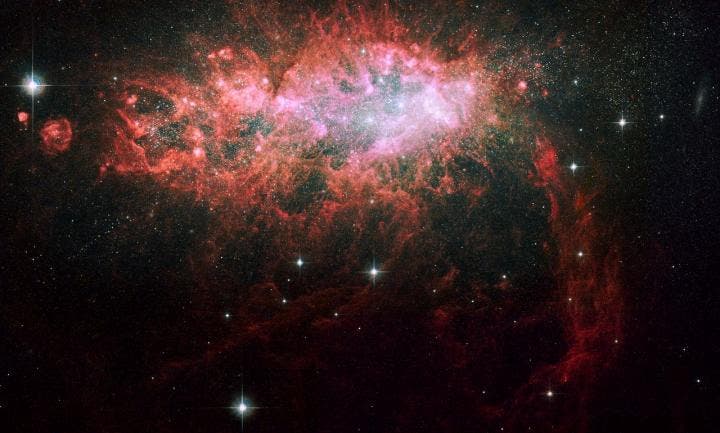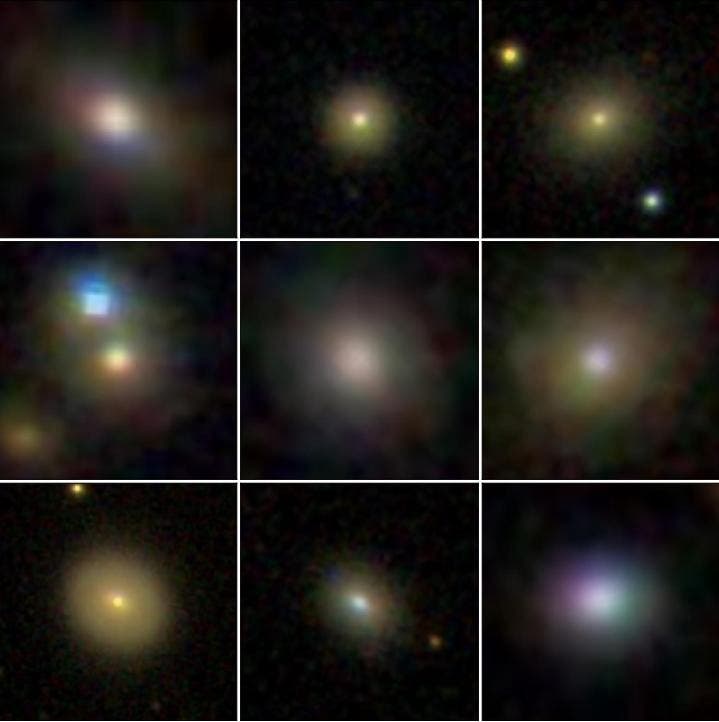
Black holes at the centre of small dwarf galaxies could slow or even halt the formation of stars via the powerful winds they produce, researchers from University of California, Riverside, have discovered. This suppression of star-formation could have a marked influence on the evolution of such galaxies.
The result seems to confirm the long-held suspicion that supermassive black holes at the centre of galaxies can influence that galaxy’s evolution — including how they grow and the way that they age. But, the research also delivers a surprise; the winds that the astronomers measured coming from the black hole were more powerful than the team reckoned for. This means that models of star formation in dwarf galaxies may require a rethink.
“We expected we would need observations with much higher resolution and sensitivity, and we had planned on obtaining these as a follow-up to our initial observations,” said Gabriela Canalizo, a professor of physics and astronomy at UC Riverside who led the research team. “But we could see the signs strongly and clearly in the initial observations.
“The winds were stronger than we had anticipated.”
Gabriela Canalizo
Thus meaning that black holes don’t just influence the development of larger galaxies, but also play a role in the evolution of smaller dwarf galaxies — galaxies containing anywhere from a few thousand to a few billion stars.
Canalizo continues: “Our findings now indicate that their effect can be just as dramatic, if not more dramatic, in dwarf galaxies in the universe.”
The study — the results of which are discussed in the Astrophysical Journal — used data collected in the Sloan Digital Sky Survey (SDSS), a project which maps 35% of the sky above Earth. In doing so, the survey has been able to identify 50 dwarf galaxies — 29 of which demonstrated clear characteristics of possessing black holes at their centres. A further six of these showed evidence of high-velocity outflows of ionised gas — the powerful winds in question.
The next step for the researchers was to use the Keck telescopes — based in Hawaii — to both detect and measure the properties of these winds, marking the first time this has been achieved.
Discussing what her team found, Canalizo adds: “We found some evidence that these winds may be changing the rate at which the galaxies are able to form stars.”
Studying dwarf galaxies could be the key to understanding how galaxies in general evolve
The study of these smaller galaxies could help scientists answer lingering about galactic evolution in general.
“Larger galaxies often form when dwarf galaxies merge together,” explains Christina Manzano-King, a doctoral student in Canalizo’s lab and the first author of the paper. As a consequence of this, she continues, dwarf galaxies are particularly useful in understanding how galaxies evolve.

“Dwarf galaxies are small because after they formed, they somehow avoided merging with other galaxies,” she adds. “Thus, they serve as fossils by revealing what the environment of the early universe was like.
“Dwarf galaxies are the smallest galaxies in which we are directly seeing winds — gas flows up to 1,000 kilometres per second — for the first time.”
Christina Manzano-King
Explaining what causes these powerful winds, Manzano-KIng points to material being fed into the black hole. This material — usually gas and dust — forms an accretion disc around the black hole. In this disc — which gradually feeds the black hole — conditions are so violent that friction and tremendous tidal forces heats the material. This releases radiative energy which shoves gas out of the galaxy’s centre and into intergalactic space.
This negatively affects the amount of gas available for star formation.
Manzano-King continues: “What’s interesting is that these winds are being pushed out by active black holes in the six dwarf galaxies rather than by stellar processes such as supernovae.
“Typically, winds driven by stellar processes are common in dwarf galaxies and constitute the dominant process for regulating the amount of gas available in dwarf galaxies for forming stars.”
Astronomers believe that winds emanating from black holes can compress gas and thus aid the gravitational collapse of gas clouds, kick-starting star-formation. But, if the wind is too strong and thus expels gas from the galaxy’s centre, rather than aiding the star formation process, gas becomes unavailable and hinders the process.
This is exactly what appears to be happening in the six galaxies that the team’s research highlighted. In these cases, the wind has had a clear detrimental impact on star formation rates.
Rethinking the relationship between black holes and star formation rates
This research may result in a rethinking of models of star formation and the evolution of galaxies. Current models do not take into account the impact of black holes in dwarf galaxies.

“Our findings show that galaxy formation models must include black holes as important, if not dominant, regulators of star formation in dwarf galaxies,” points out Laura V. Sales, assistant professor of physics and astronomy at UC Riverside.
As for the future of this research, the team next plans to investigate characteristics of gas outflows such as mass and momentum.
“This would better inform theorists who rely on such data to build models,” concludes Manzano-King. “These models, in turn, teach observational astronomers just how the winds affect dwarf galaxies.
“We also plan to do a systematic search in a larger sample of the Sloan Digital Sky Survey to identify dwarf galaxies with outflows originating in active black holes.”
Original research: ‘AGN-Driven Outflows in Dwarf Galaxies’ Christina M. Manzano-King, Gabriela Canalizo, and Laura V. Sales.









